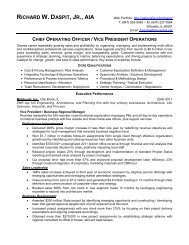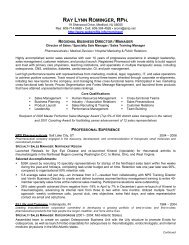The Art of Practical and Precise Strain Based ... - Webprofile.info
The Art of Practical and Precise Strain Based ... - Webprofile.info
The Art of Practical and Precise Strain Based ... - Webprofile.info
- No tags were found...
Create successful ePaper yourself
Turn your PDF publications into a flip-book with our unique Google optimized e-Paper software.
Applications Note 1-3result in a perceived signal 3.38% less than the true open circuit voltage the strain bridge wouldotherwise provide. Although the zero hertz case is useful to consider, most measurement systemsare required to measure dynamically changing inputs. In this case, equation 1-1 isextended to encompass the dynamic case by replacing resistances with impedances Z output <strong>and</strong>Z instrument .It is equally important to be aware that energy will be exchanged between the sensor <strong>and</strong> theenvironment in many different forms <strong>and</strong> via many different paths where all forms <strong>and</strong> paths <strong>of</strong>energy ßow must be considered for valid <strong>info</strong>rmation to result.4. All sensors respond to all inputs; it is simply a matter <strong>of</strong> the degree <strong>of</strong> the response. If our goalis to design an accelerometer, we would, <strong>of</strong> course, set out to design the device so that it is notinfluenced by temperature, pressure, rate <strong>of</strong> temperature change, humidity, substrate strain, radiation,transverse acceleration inputs, <strong>and</strong> a host <strong>of</strong> other possible characteristics <strong>of</strong> the environment.In reality, this is not achievable. <strong>The</strong> physical constraints <strong>of</strong> having to fabricate sensorstructures with imperfect materials, having imperfectly-toleranced subcomponent parts <strong>and</strong> inusing less-than-perfect transduction methods, means that we must carefully design the sensorwith these shortcomings in mind.5. As the <strong>info</strong>rmation provided by a sensor is conducted, conveyed, transformed into other energyforms, or interpreted, it is degraded at every opportunity. <strong>The</strong> r<strong>and</strong>om content <strong>of</strong> any organizedform <strong>of</strong> energy will increase at any <strong>and</strong> all opportunities. <strong>The</strong> act <strong>of</strong> amplifying a sensor signalwill undoubtedly increase the magnitude <strong>of</strong> the perceived signal but will likewise increase thepercentage <strong>of</strong> r<strong>and</strong>omness or noise that is present in the amplified signal. In many ways, the tendencytowards r<strong>and</strong>omness may be likened to the thermodynamic property <strong>of</strong> entropy which isthe irreversible tendency <strong>of</strong> a system or the universe toward increasing disorder.<strong>The</strong> focus <strong>of</strong> the instrument engineer is to be aware <strong>of</strong> the consequences <strong>of</strong> thepresence <strong>of</strong> the sensor within a system, to minimize the influence that the sensorwill have on the measured phenomena as well as being aware <strong>of</strong> the influence <strong>of</strong>other aspects <strong>of</strong> the environment on the quality <strong>of</strong> the <strong>info</strong>rmation that the sensorprovides.It is the sensor that is the source <strong>of</strong> <strong>info</strong>rmation upon which aerodynamicists makedesign modifications, how an old bridge is buttressed, or whether the air bag in ourautomobile should initiate. It is the quality <strong>of</strong> this <strong>info</strong>rmation that will establishour success, or in some cases, our very survivability. <strong>The</strong> strain-based sensor, themost prevalent sensor type in the world today, is the focus <strong>of</strong> the following dissertation.<strong>The</strong> <strong>Art</strong> <strong>of</strong> <strong>Practical</strong> <strong>and</strong> <strong>Precise</strong> <strong>Strain</strong> <strong>Based</strong> Measurement 2nd Edition © 1999 CHAPTER 1-11
















